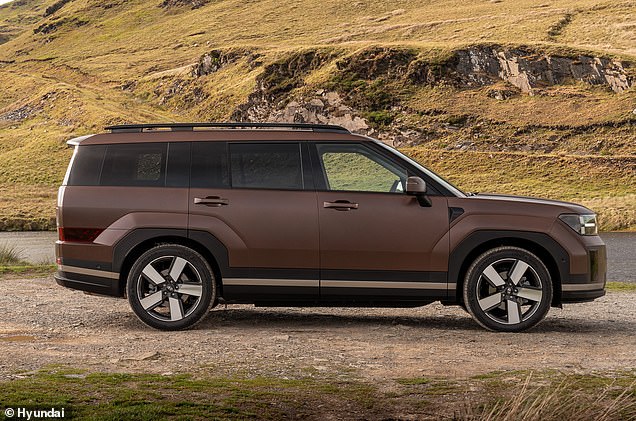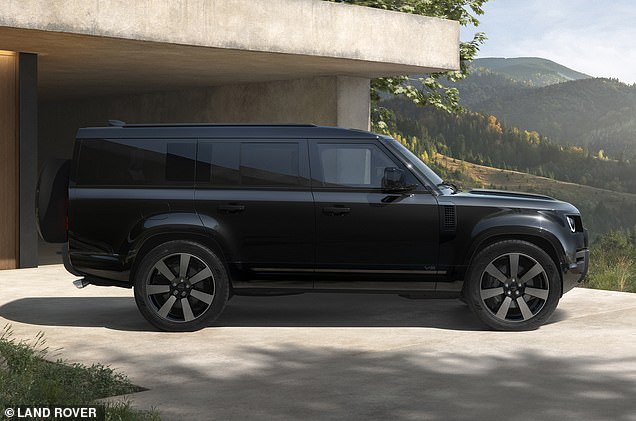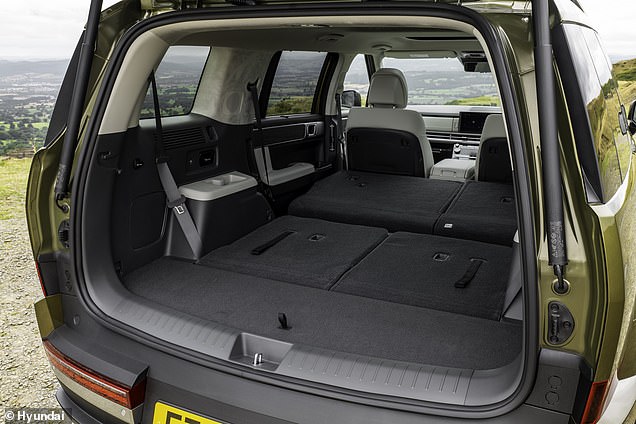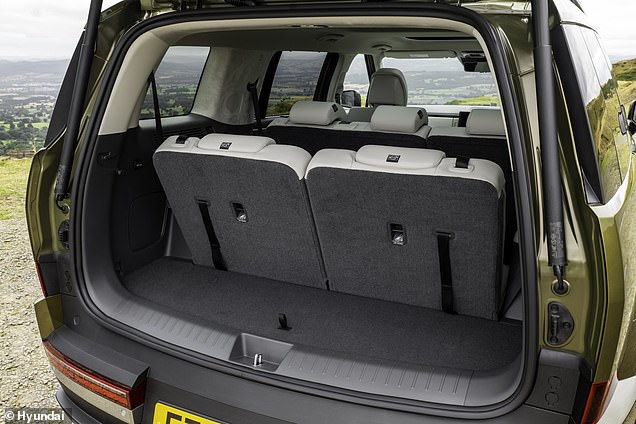‘Nice Land Rover Defender, mate,’ yells a neighbour as I unlock the latest enormous motor parked on the drive.
Given the popularity of JLR’s best-selling car, Hyundai’s design team will probably take his confusion for compliment – especially considering the Santa Fe is almost half the price.
But this is by no means a Korean knock-off product.
Loaded with equipment, fancy tech and an abundance of comfort features, the latest Santa Fe is proof of just how far Hyundai has come in the last decade.
In fact, it has been labelled by many to be the principal seven-seat car on the market today, irrespective of price.
So, what better way to test this statement then to take it away for a UK break with family and friends where it will be loaded with luggage, driven across country and utilised as a six-person shuttle for a week… with yours truly the perennial designated responsible adult.
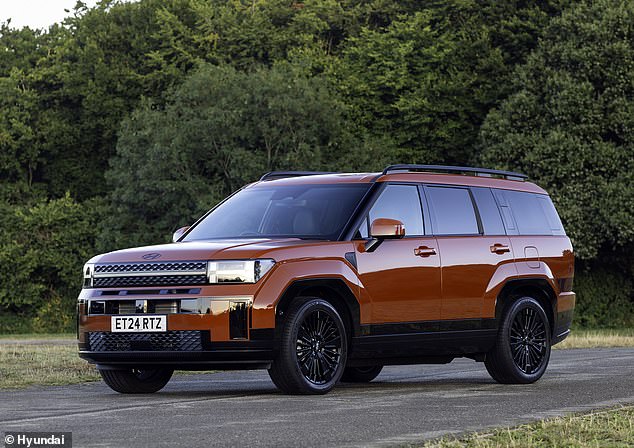
Is this the best seven-seater on sale? Hyundai’s Santa Fe might have marmite looks but there’s no doubting its roominess. Daily Mail Motoring Editor Rob Hull has spent a week to see if it really is the cream of the seven-seat crop
Marmite looks won’t be to everyone’s taste
I can forgive the guy who lives across the road for mistaking the Santa Fe for a Defender, given its similar profiled silhouette.
The boxy cab-back outline, squared-off wheel arches, and almost perfectly rectangular side windows – which could have been penned with an Etch A Sketch – are part of the ubiquitous design philosophy deployed by Land Rover for decades.
And, from this side-on profile it looks great. As does the front.
A new ‘H’ shaped headlight signature is stylish as well as a nod to the brand. And the tiered black-on-black vented bonnet and bumper grilles give a menacing appearance that will have an imposing presence in any rear-view mirror.
But my major reservation is at the rear, where it appears Hyundai’s design team had already packed up their pencil cases and headed home.
With such a slab-backed canvas to work with, the low-mounted brake light bar – while also incorporates the ‘H’ – ruins the proportions of the car, making it look top-heavy and clumsy from the viewpoint of following vehicles.
I can’t recall a new model of late that’s split my stylistic tastes so much as the Santa Fe.
You can easily forgive my neighbour’s confusion for the Land Rover Defender. The Hyundai Santa Fe’s (left) boxy silhouette, squared-off wheel arches, rectangular windows and slab-back tailgate are very similar to the Defender (pictured right, Land Rover Defender 130)
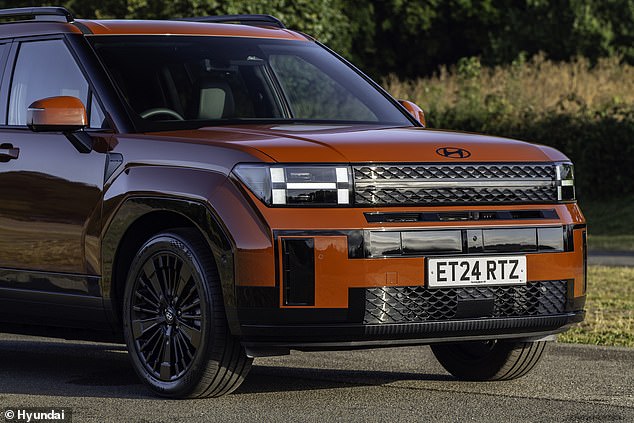
A new ‘H’ shaped headlight signature is stylish as well as a nod to the brand. And the tiered black-on-black vented bonnet and bumper grilles give a menacing appearance
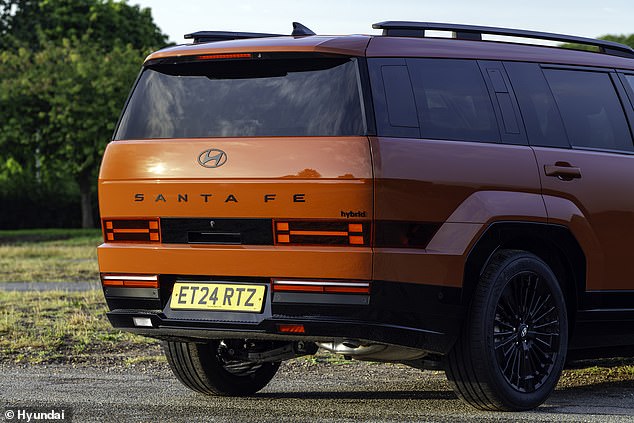
As much as Rob likes the front styling, he thinks Hyundai’s design team had already packed up their pencil cases and headed home before working on the slab-backed rear
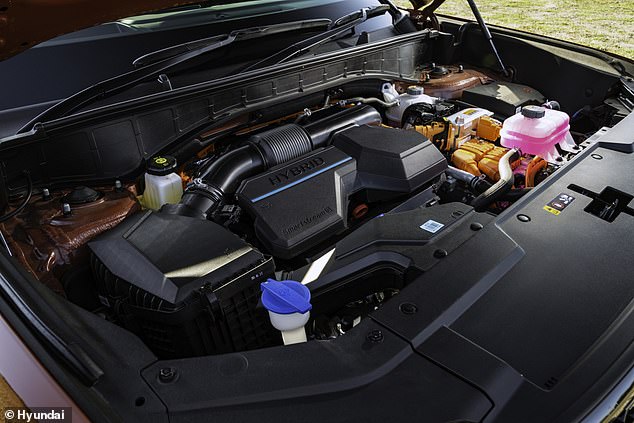
Customers have the choice of a conventional hybrid or a plug-in hybrid drivetrain. There is no conventional petrol or diesel engine here
What’s under the bonnet?
The Santa Fe is an exclusively hybrid product for the UK market.
Two engine options are available: a conventional ‘self-charging’ hybrid (HEV) and a plug-in hybrid (PHEV).
They offer electrified support to the same 1.6-litre petrol engine married to a six-speed automatic gearbox.
The entry HEV (from £47,890) is front wheel driven, though for an extra £2,000 customers can upgrade to four-wheel drive (from £49,945). The PHEV is exclusively 4X4 and starts from £51,995.
Neither option is what you’d call potent – or fast.
My range-topping all-wheel-drive HEV has 212bhp, which is more than ample for most large family saloons and estates but a tad underpowered for an SUV tipping the scale at almost two tonnes (1,900kg) unladen.
The PHEV supplies a combined output of 250bhp and is some 0.3 seconds faster than the HEV to 62mph, though taking 9.5 seconds to marginally exceed the national speed limit still isn’t what you’d call brisk.
That said, in most day-to-day driving scenarios, the HEV feels punchy enough.
Accelerating on a short motorway entry slip road, you’ll need to mush the throttle pedal deep into the footwell carpet to reach a speed to match the 70mph of fast-moving traffic already in lane one.
Exciting, it isn’t. But it’s adequate.
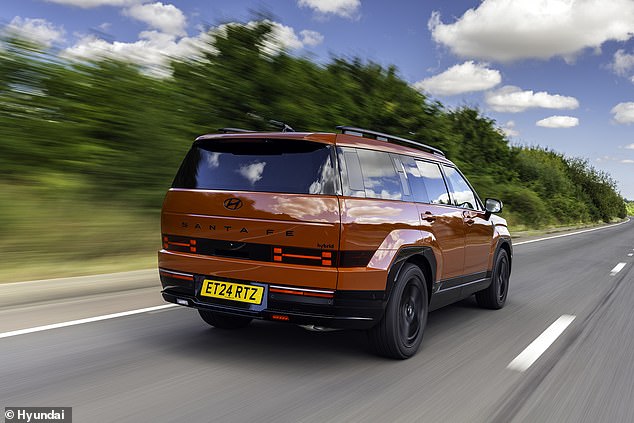
The hybrid line-up does feel somewhat underpowered, offering 212bhp to shift a near two-tonne SUV
At lower speeds, trundling through town and navigating narrow twisty roads on the school run, it’s smooth and quiet. Though the PHEV can be quieter for longer.
The plug-in version offers up to 34 miles of pure electric driving (granted the battery has been fully charged, which takes three and a half hours using a standard 7kW homecharging wallbox).
That’s something of a disappointment, though, given the Skoda Kodiaq PHEV offers more than 70 miles in EV-only mode. That said, the Kodiaq PHEV is not available with seven seats – you’ll have to plump for the mild-hybrid 148bhp 1.5-litre turbocharged petrol if you want the extra two chairs in the Czech rival.
The HEV’s electric mileage is far more limited: you’ll struggle to do even a handful of miles without the petrol engine thrumming into action.
That said, the contrasting chug of the four-cylinder engine is well insulated from the cabin, making this a relatively hushed ride unless you’re particularly heavy-footed with the accelerator.
Wind and road noise is well deflected from the interior too, which is an impressive feat for a car with all the aerodynamic svelteness of a cinder block.
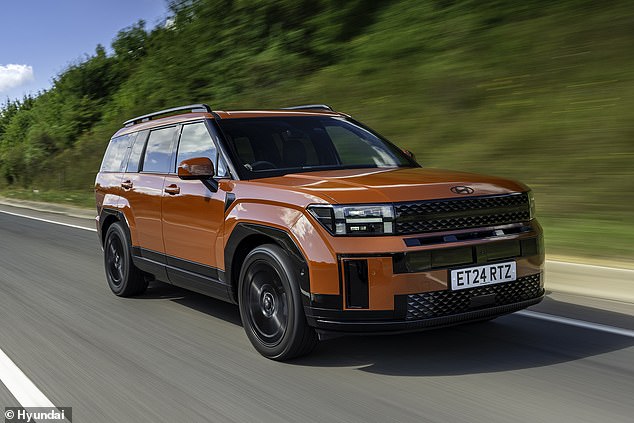
At speed, the body control is impressive, with the suspension tuned for optimal on-road performance. Few owners will be taking Santa Fes off the beaten track
Cornering and ride comfort
As well as being well muted, the HEV is incredibly easy to drive. That doesn’t sound like much of a compliment but, given its hulking dimensions, is laudable praise.
The steering is accurate and well weighted. The square-shaped windows provide bountiful visibility. And the four corners of the car are easy to predict. This combination makes narrow manoeuvres and parrallel parking less challenging than you’d expect from a vehicle that’s over 4.8 metres long.
At speed, the body control is also impressive, with the suspension tuned for optimal on-road performance. I – nor Hyundai – envisage many owners will be taking Santa Fes off the beaten track too often.
Pitch and swaying of the body on sudden direction changes is kept to a minimum, while the grip levels are more than enough to suit a large family SUV that’s unlikely to be driven in anger by parents with aspirations of contract offers from F1 teams.
Agile, the Santa Fe is not. But it’s well composed for a jacked-up seven-seater.
There are easily audible thuds when driving over speed humps or when a hapless driver fails to avoid a pothole. And this became more prominent when carrying five passengers or a boot-full of military-like essentials required of a family trip with a toddler. However, my test car had enormous (optional) 20-inch wheels, which do little to bolster ride acoustics.
The rivalling Skoda Kodiaq certainly feels plusher and does a better job of masking its bulk.
Caravanners might be disappointed by the lack of a frugal, torquey diesel engine for towing, but even with its hybrid exclusivity, the Santa Fe can pull over a tonne of weight and comes with self-levelling rear suspension.
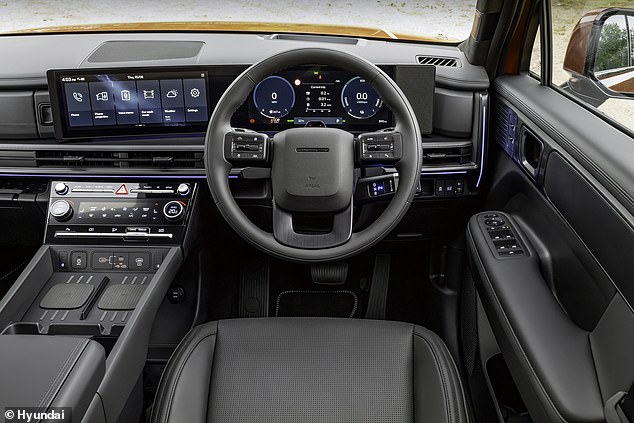
The cabin feels seriously plush, with a pair of digital displays and high-end materials across the cockpit
A premium cabin without a luxury price tag
If my neighbour thought the outside looked like a Land Rover Defender, he would have been pretty convinced if I’d invited him to check out the interior, with the cabin featuring hallmarks you’d typically expect in luxury vehicles.
The cockpit merges a pair of 12.3-inch screens – one for the driver’s instrument display and the other the infotainment touchscreen.
They use the Korean firm’s latest pin-sharp graphics and – for the infotainment setup – a responsive and accurate operating system that even the most ardent technophobe could get to grips with quickly.
It too – like just about any new car sold in 2025 – offers compatibility with Android Auto and Apple CarPlay.
This, by admission, has become my default option, especially on longer – less familiar – journeys when the up-to-date accuracy of Google Maps is paramount to limit time spent with an irritable toddler strapped into a car seat like a two-foot Hannibal Lecter gagging to be set free.
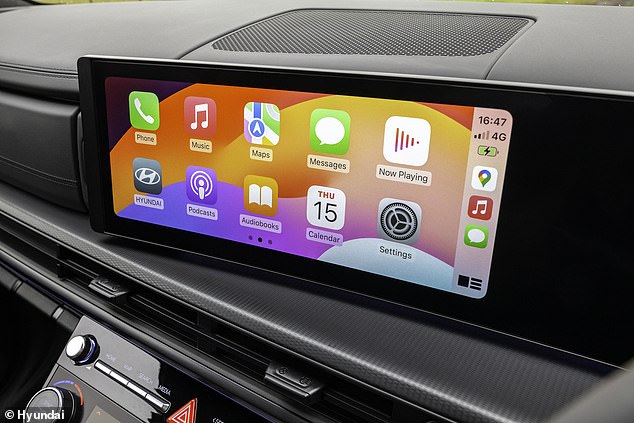
As with most new cars entering the market today, the Santa Fe has compatibility with Apple Car Play and Android Auto. However, it’s own touchscreen operating system is very easy to use
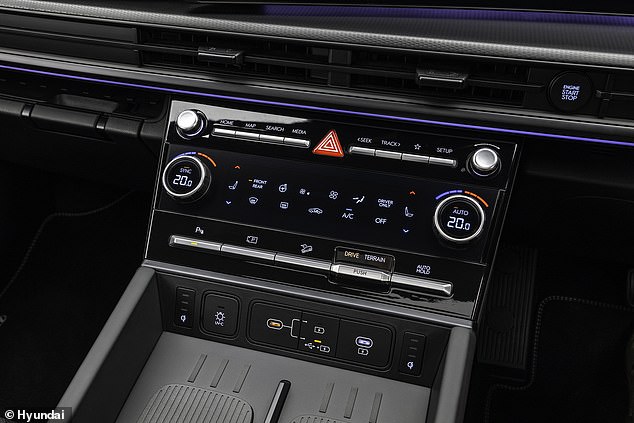
We’re not huge fans of digital temperature controls, especially those placed lower in the dashboard that require a driver to look down to make adjustments. However, there are at least some physical dials and a logical layout
Directly below the infotainment display is a third – 6.6-inch – screen permanently showing the climate controls with dials flanking either side.
Now, we’re not always fans of temperature settings being buried in touchscreens – especially those positioned low in the centre console, thus requiring a driver to divert their eyes far away from the road in front of them – but at least in the Santa Fe it’s logically set out and easy to navigate once it becomes familiar.
Away from the digital elements of the cabin, the layout and materials strewn across the interior imply a more premium product than some might expect from the Hyundai badge stamped onto the bonnet.
Even the steering wheel’s lack of branding – instead using the company’s four-dot lighting icon – masks the true identity of the car.
All the major touchpoints feel deluxe and very high quality.
Okay, there are some places where the look is greater than the touch – namely the metal-effect dials and switchgear, which feel flimsier than the machined-appearance suggests. But for a keenly priced seven-seat SUV from a mainstream brand, it’s unmatched.
A Nissan X-Trail definitely doesn’t feel as high end as this.
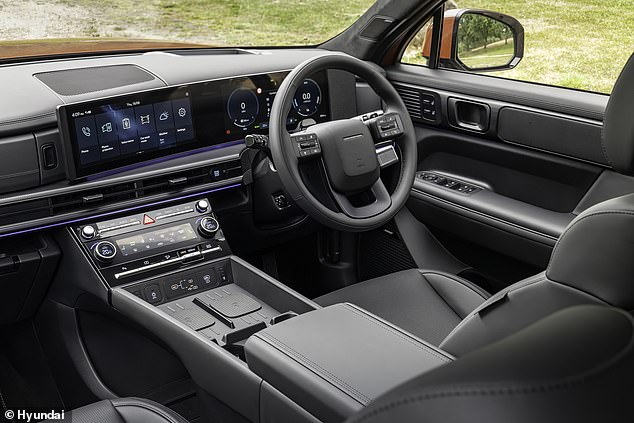
Up front, there’s elbow room aplenty. In fact, you’re sat so far away from the passenger to your left that you’ll almost have to cup an ear if they’re a mumbling type
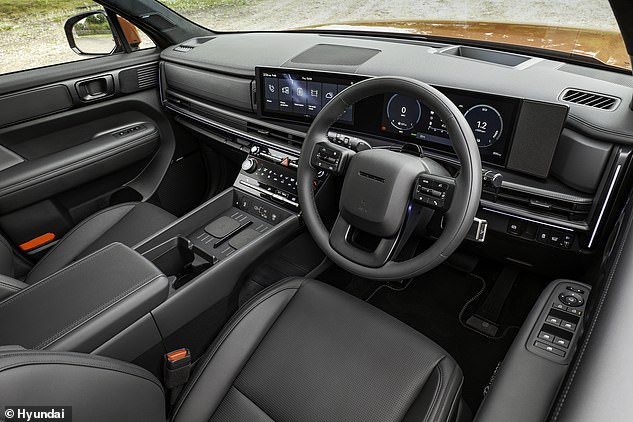
The front seats are divided by a wide central console tunnel. It has substantial cupholders, charging pads for two smartphone, and a massive armrest with storage inside
Space in abundance
If roominess is top of the order for your next family car, the Santa Fe is about as accommodating as it gets.
Up front, there’s elbow room aplenty. In fact, you’re sat so far away from the passenger to your left that you’ll almost have to cup an ear if they’re a mumbling type.
This is partly thanks to the thickness of the console tunnel dividing the seats, which has substantial cupholders that’ll swallow a large McDonalds milkshake cup, a huge tray that provides charging pads for two smartphone, and a massive armrest with storage within.
Add to this a capacious glovebox, a cubby storage section above this and – in the top-spec Calligraphy spec – a dashboard compartment with UV lighting to sterilise objects inside. In short, this is the sort of cabin that you can easily lose things in.
It’s worth mentioning here that there’s ample adjustment for the driver’s seat.
Individuals of varying heights, sizes and ailments should be able to get the chair and wheel into a position that suits their needs while delivering a brilliant view of what’s beyond the nose of the bonnet lid.
My Calligraphy trim also featured the Relaxation Seat option, which are fantastically supportive and comfortable. But their real party piece is that they can be reclined all the way back and – with the addition of fold-out leg rests – allow you to relax in supreme comfort when you’re parked up at the school gates waiting for your clan of kids to come bounding out.
But as impressive as the Santa Fe is up front, it’s in the rear where it’s a class leader.
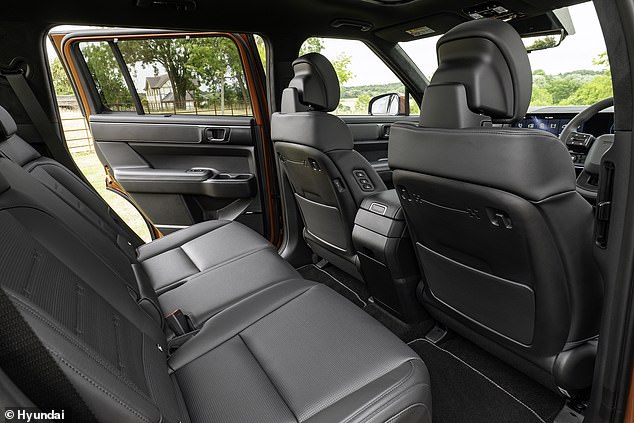
The square shaped doors open wide to provide easy entry and exit to the vehicle. The large rectangular wheels also allow plenty of light into this enormous seven-seat motor
Huge apertures and wide opening doors give the rear access a tunnel-like opening.
Once inside, the second row of seats offers vast head, shoulder, and leg room. We’d defy a basketball team not to get comfortable in this car.
And this can be improved further if you opt for the six-seat layout option, which deletes the central base across the bench – though this, again, is only available to those who stump up the funds for the top-of-the-range trim and are willing to pay a few hundred quid extra for less practicality.
If passenger space is a premium over boot capacity, the third row of seats – a pair of pop-up chairs out of the floor – are spacious by seven-seat SUV standards.
Okay, the high floor section means your knees are up near your stomach, so taller adults wouldn’t want to sit there for too long, but there’s still ample head room thanks to the cube-like proportions of the Santa Fe.
What also gives the Hyundai’s third row an edge over rivals like the Peugeot 5008 and Skoda Kodiaq is the availability of USB-C chargers, air vents and cupholders for both occupants.
When the third row isn’t occupied, the Santa Fe provides van-like luggage capacity.
My hybrid version offered up 628 litres of boot space – and I filled it with suitcases, a pushchair and all the equipment required of a week away with a two-year-old.
Customers should note that the PHEV variants have a slightly smaller 621 litres of loading space.
Fold the second row of seats flat and your mate with a Transit will be jealous of the luxurious load lugging you can do. You’d easily get a blow-up mattress in there, with a six-footer sleeping in relative comfort too.
Again, the boot door is square in shape with a low loading sill. Getting bulky items in and out of this thing is a piece of cake.
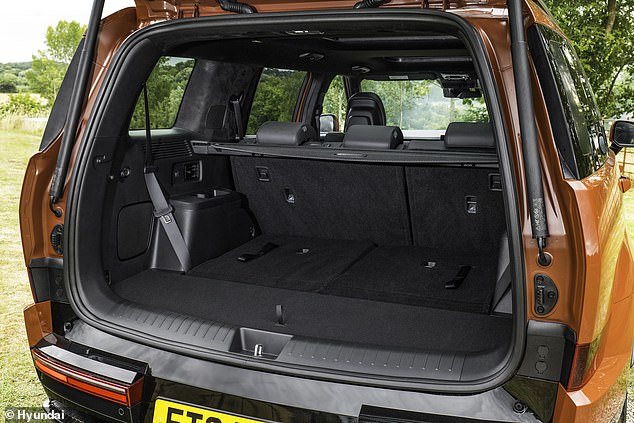
A pair of additional chairs pop out of the boot floor and offer decent levels of roominess. With the seats folded flat, the loading capacity is 628 litres
With the second and third row of seats folded flat, your mate with a Transit van will be very jealous of your car’s luxurious load lugging capabilities. With the third row of seats erected, there’s still a small about of boot space available
Running costs
Any opinion that Korean cars are a ‘cheap’ option is outdated. Both Hyundai and Kia have taken major steps upmarket – and the quality of their latest cars warrant the steeper asking prices.
But when you compare this to mainstream rivals – like 5008 (from £39,890) and Kodiaq (from £39,000) – it is notably more expensive to the tune of £8,000.
Even the Kia Sorento sister car has a start prices that takes a lesser toll on your bank account.
While the entry Premium spec [yes, I also think it’s odd to call the entry spec ‘premium’] hybrid starts from £47,890, mid-trim Ultimate rings in from £51,390 and range-topping Calligraphy is from an eye-watering £53,890. The PHEV pushes prices even higher.
However, compared to the cheapest seven-seat Land Rover Defender 130 (starting from £84,070), it’s a bargain.
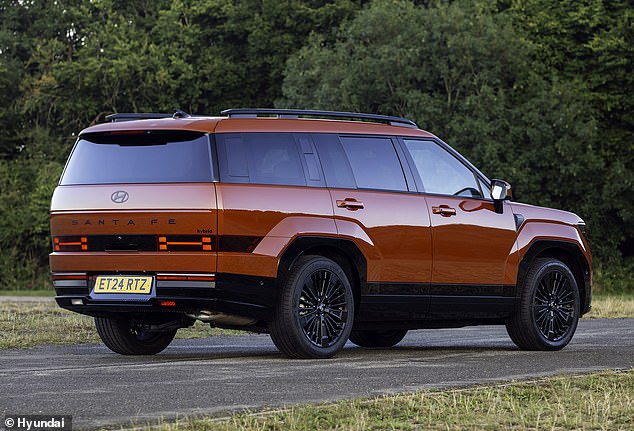
The Santa Fe isn’t cheap. In fact, it’s around £8,000 pricier than seven-seat rivals from Peugeot and Skoda
My pick of the bunch – from a regular car buyer’s perspective – would be the conventional hybrid with two-wheel drive.
It combines the cheapest purchase price with the best fuel economy and – given the limited power on tap across the range – no dramatic loss in performance.
Of the three time levels, the entry Premium is so well equipped that it’s not worth paying thousands more to move up. It has heated front seats, wireless phone charging, an electrically-assisted boot door, adaptive cruise control, and a raft of other kit.
For company car drivers, the PHEV will be preferable choice because it’s in a lower BIK band. However, the PHEV’s limited EV-only range means it is more to tax than its more electrically-assisted 5008 and Kodiaq rivals.
Officially, the Santa Fe PHEV produces 38g/km of CO2, while the HEV is four times higher at 155g/km.
Remember, new Hyundais all come with a five-year, unlimited mileage warranty, which gazumps most rivals manufacturers.
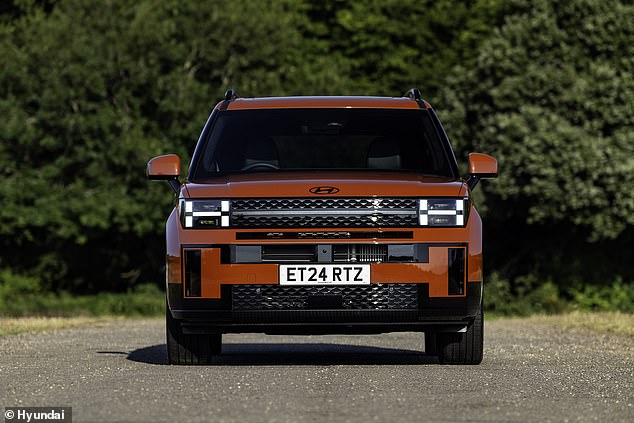
Few SUVs of any price can seat up to seven people in such comfort – even those crammed into the rearmost chairs, Rob concludes
Cars & Motoring Verdict
If I was to buy a Santa Fe, it’s a car I would reverse park up to a wall or a garage on the driveway just to spare the eyes of passers by from the exposure to its rear-end design.
But from every other angle it looks great, and the cabin is a comfortable, luxurious and stylish place to be.
Could the engines do with a little more poke? Absolutely.
In fact, Hyundai’s largest combustion SUV feels like it would be best-suited to a torquey diesel engine that can haul its considerable weight with fewer revs. But, given the current environmental climate, I can understand why hybrid is the direction the brand’s taken. It’s just a shame that the bhp versus kg ratio isn’t better.
Another disappointment is the lack of EV-only range from the PHEV model (which I haven’t yet driven). Just 34 miles of electric driving from a plug-in hybrid car of any scale is lacklustre by 2025 standards.
Pricing will be an issue for some too, especially with rivals undercutting Santa Fe by around £8,000.
But when it comes to roominess, the Santa Fe is unmatched.
Few SUVs of any price can seat up to seven people in such comfort – even those crammed into the rearmost chairs. The boot is cavernous too.
Is it the best seven-seater you buy right now?
In terms of spaciousness, premium feel at a reasonable cost, and bundles of practicality, I think it’s the pick of the bunch – even better than the £80k-plus Land Rover Defender equivalent.


